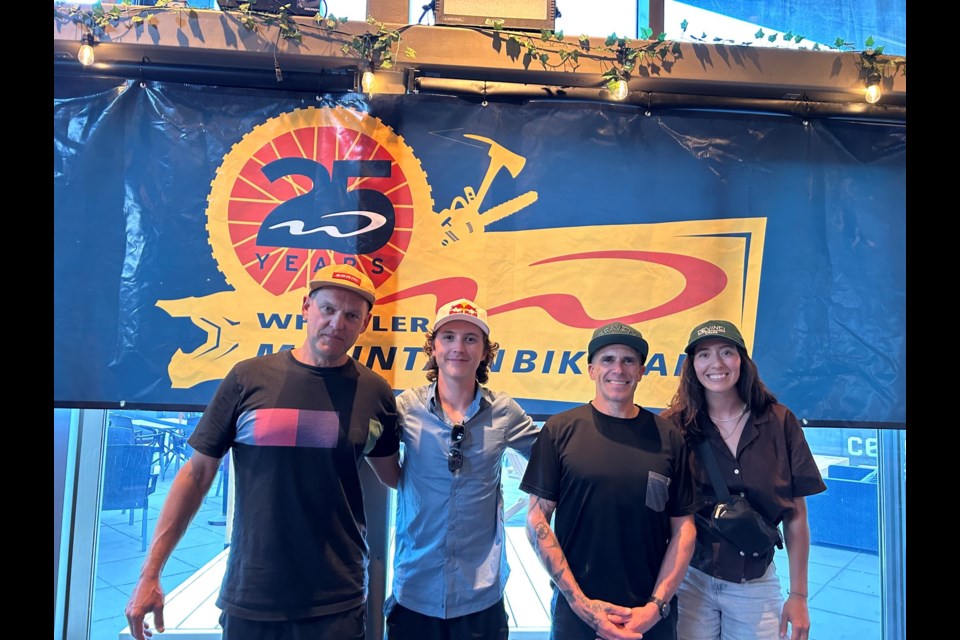For older locals reading this story, it might be hard to believe the Whistler Mountain Bike Park (WMBP) has been around for 25 years already. For youngsters, it's hard to imagine life without such a thing.
It's likewise difficult to encapsulate a quarter-century of loam trails, gnarly tricks, breakneck speed and generational progression through storytelling, but the WMBP is doing its best with a new 25th anniversary speaker series. The first of these events went down on July 10 with four rock stars of the sport taking centre stage.
Jackson Goldstone is firmly entrenched as one of Canada's favourite riders after a 2023 campaign that saw him seize two World Cup downhill victories and a runner-up spot in the overall ranking.
Georgia Astle is something of a local legend: a two-time Garbanzo DH winner and all-around Crankworx veteran now transitioning into freeride.
Chad Hendren owns Gravity MTB and works as head coach for the national downhill team. He also prevailed in the WMBP's very first DH race on Sept. 4, 2001.
Andrew Shandro boasts World Cup wins, Canadian titles and an X Games gold medal on his resume, plus his role as Trek Factory Racing's downhill team manager and owner of Summer Gravity Camps (SGC).
People flocked to the Garibaldi Lift Company (GLC) to hear the panel share its thoughts, moderated by longtime Crankworx host Derek Foose.
If you build it, they will come
During its early years, the WMBP attracted a fraction of the number of guests it does now.
Trails were relatively rough and limited in number. Equipment of the '90s and early 2000s was primitive compared to what manufacturers like Trek, Specialized and Commencal are making now: handlebars were narrow, build geometry was wildly different and helmets were, according to Hendren, "terrible."
These factors did not stop a generation of pioneers from taking to the slopes with vigour, carrying their vehicles on their laps before the advent of bike racks on chairlifts. It's no surprise they did, for Whistler is an example of the old adage: "if you build it, they will come."
The diehards of Hendren and Shandro's heyday blazed a route for others to follow as new zones like Garbanzo in 2004 and Creekside in 2015 expanded the local menu into a smorgasbord of riding options. Tourism Whistler statistics count roughly three million visitors to the resort each year, with 55 per cent of them showing up to enjoy summer activities like biking.
"There's a vision of the bike park and people behind it that made the park happen," Shandro pointed out. "The access to coaching and training, and the passion that is in this valley, is bar none. It's a special place. We all know that, and we're all fortunate to be able to play here."
The WMBP's literal growth in size is mirrored by the emergence of different pathways into racing.
Goldstone has what you might call a conventional success story. He's a homegrown boy who rode his first bike at three years old and just kept going until he became an elite downhiller. The Squamolian can't pinpoint an exact moment he chose to be a pro—his trajectory has simply reflected his love for mountain biking.
On another end of the spectrum is Astle, the daughter of two ski bums who grew up snowboarding and playing hockey. She didn't even realize she lived next to a top-flight bike park as a girl, and didn't truly find it until high school. Astle proceeded to make up for lost time, "skipping every single stop sign" en route to her first downhill World Cup (in her second year of racing).
'The greatest ever'
Go to the Bike Park on any given day of the season and you'll find a melting pot of patrons from all walks of life. Some kids are already excellent riders at nine or 10 years of age, while others keep it rolling well into their 60s. There are internationals from all kinds of countries and far more women than years before.
None of it would have happened without a sustained full-court press from the biking community in terms of mentorship. Indeed, coaching future generations of talent can be just as gratifying as lapping A-Line on a bluebird day—perhaps even more so.
"I never thought I'd be doing this as a career. It just happened," said Hendren. "As a coach. I'm here to help people. I'm here to help everybody who rides a bike, no matter where you are.
"I look at Miranda Miller. I used to ride with her all the time and we used to do Cycling BC DH camps. Seeing her come away with [medals] hits me pretty deep. Things like that are the greatest ever … and knowing that you've been a small part of [another person's success] is huge."
At age 17, Astle became a pilot project of sorts for Ride Like a Girl: a non-profit organization that helps young female bikers find professionals, skill clinics and community events designed to level up their confidence. She has since returned to the program to mentor fellow Whistlerite Mhairi Smart and hopes to do more when her competitive schedule allows.
"It started off as just a summer job," Astle said. "I was coaching because that was what I wanted to do. Ultimately … you love riding that much, you get to show people how much you love it and teach them to love it too. It's like the whole package."
Crankworx Whistler kicks off July 19 and promises to be another iconic chapter in the history of a park that revolutionized mountain biking: from athletes to brands to other venues around the globe. In all likelihood, the story has just begun.
Goldstone certainly feels that way.
"A quarter of a century is a big milestone, especially for such an amazing place like Whistler," he said. "It's definitely going to make it to that century mark. I don't see this place stopping anytime soon."




